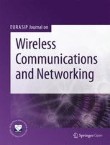EURASIP Journal on Wireless Communications and Networking welcomes submissions to the special issue on '5Gwireless - Innovative Architectures, Wireless Technologies and Tools for High Capacity and Sustainable 5G Ultra-Dense Cellular Networks'.
5G systems need to be capable of providing 1000 times higher capacity and a 90% reduction in energy consumption compared to today standards, in order to cope with the impressive increase of mobile data traffic and to reduce the ever increasing carbon emission footprint of mobile communications. 5G networks will enable digital sensing, communication and processing capabilities to be ubiquitously embedded into everyday objects, turning them into the Internet of Things (IoT). In this new paradigm, smart devices will collect data, will relay information or will contend for wireless access, and will perform most processing collaboratively over 5G cellular networks. 5G cellular networks are coming. What architectures, topologies and technologies will define 5G cellular networks? What methodologies shall be used to their analysis, design and optimization? Most probably, no single architecture and technology will be capable of meeting all requirements of 5G networks, as a function of the requested quality of service, user-experience, desired performance, hardware and signal processing complexity constraints and channel conditions. In the light of that, and in stark contrast with previous generations of cellular networks that were characterized by fixed radio parameters and spectrum blocks, 5G networks will be allowed to opportunistically utilize never used frequency bands and to exploit multiple technologies for guaranteeing the best delivery of services to the end users. As such, 5G will not be a mere evolution of the status quo, but it will need radical and disruptive changes in its architectures, topologies and technologies. The overarching objective of this 5Gwireless special issue is to discuss the most promising architectures, topologies, and technologies, which will significantly shape 5G standards and will enable the requested 1000 times increase of spectral efficiency and 90% reduction of energy consumption.
Potential topics include but are not limited to:
- Beamforming Techniques
- Massive MIMO Systems
- Network MIMO
- Multi-cell Systems and Interference
- Millimeter Wave Communications
- Limited Feedback
- Ultra-Low Delay Communication
- Channel Modelling and Estimation
- Compressive Sensing and Sparse Processing
- Machine Learning for PHY/MAC Design
- Multi-Antenna Techniques and Security
- Spatial Modulation
- Ultra-Dense Cellular Networks / HetNets
- Stochastic Geometry Modeling and Analysis
- Field Trials and Demonstrators
- MIMO Radar and Multi-sensor Processing
- Cooperative and Sensor Networks
- Device-to-Device Communications
- Uncoordinated and massive access
- UAVs
- Network slicing
- SDN/NFV
- Energy Efficiency
- Multi-objective optimization
Submission Instructions
Before submitting your manuscript, please ensure you have carefully read the submission guidelines for EURASIP Journal on Wireless Communications and Networking. The complete manuscript should be submitted through the EURASIP Journal on Wireless Communications and Networking submission system. To ensure that you submit to the correct special issue please select the appropriate special issue in the drop-down menu upon submission. In addition, indicate within your cover letter that you wish your manuscript to be considered as part of the special issue on '5Gwireless - Innovative Architectures, Wireless Technologies and Tools for High Capacity and Sustainable 5G Ultra-Dense Cellular Networks'. All submissions will undergo rigorous peer review and accepted articles will be published within the journal as a collection.
Deadline for submissions:
1st April 2019
Lead Guest Editor:
Marco Di Renzo, Paris-Saclay University / CNRS, France
Guest Editors:
Alessio Zappone, CentraleSupelec, France
Luca Sanguinetti, University of Pisa, Italy
Vincenzo Sciancalepore, NEC Europe Laboratories, Germany
Emil Björnson, Linköping University, Sweden
Antonio Pascual-Iserte, Polytechnic University of Catalonia, Spain
Cheng-Xiang Wang, Heriot-Watt University, UK
George Agapiou, OTE Academy, Greece
Submissions will also benefit from the usual advantages of open access publication:
- Rapid publication: Online submission, electronic peer review and production make the process of publishing your article simple and efficient
- High visibility and international readership in your field: Open access publication ensures high visibility and maximum exposure for your work - anyone with online access can read your article
- No space constraints: Publishing online means unlimited space for figures, extensive data and video footage
- Authors retain copyright, licensing the article under a Creative Commons license: articles can be freely redistributed and reused as long as the article is correctly attributed
For editorial enquiries please contact vincent.salvo@springer.com.
Sign up for article alerts to keep updated on articles published in EURASIP Journal on Wireless Communications and Networking - including articles published in this special issue!
